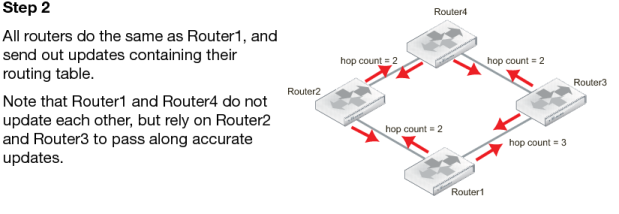The Bellman–Ford routing algorithm
The routing algorithm used by RIP was first used in 1967 as the initial routing algorithm of the ARPANET. The Bellman–Ford algorithm is distributed because it involves a number of nodes (routers) within an Autonomous system, and consists of the following steps:
1. Each node calculates the distances between itself and all other nodes within the AS and stores this information as a table.
2. Each node sends its table to all neighboring nodes.
3. When a node receives distance tables from its neighbors, it calculates the shortest routes to all other nodes and updates its own table to reflect any changes.
To examine how this algorithm functions let’s look at a network with 4 routers — routers 1 through 4. The distance from router1 to router2 is 2 hops, 1 to 3 is 3 hops, and 2 to 3 is 4 hops. Router4 is only connected to routers 2 and 3, each distance being 2 hops.
1. Router1 finds all the distance to the other three routers — router 2 is 2, router 3 is 3. Router1 doesn’t have a route to router 4.
2. Routers 2 through 4 do the same calculations from their point of views.
3. Once router 1 gets an update from router 2 or 3, it will get their route to router 4. At that point it now has a route to router 4 and installs that in its local table.
4. If router1 gets an update from router3 first, it has a hop count of 5 to reach router4. But when router2 sends its update, router1 will go with router2’s shorter 4 hops to reach router4. Future updates don’t change this unless they are shorter than 4 hops, or the routing table route goes down.
Figure 100: RIP algorithm example in 4 steps
The good part about the Bellman-Ford algorithm in RIP is that the router only uses the information it needs from the update. If there are no newer, better routes than the ones the router already has in its routing table, there is no need to change its routing table. And no change means no additional update, so less traffic. But even when there is update traffic, the RIP packets are very small so it takes many updates to affect overall network bandwidth. For more information about RIP packets, see
“RIP packet structure”.
The main disadvantage of the Bellman–Ford algorithm in RIP is that it doesn’t take weightings into consideration. While it is possible to assign different weights to routes in RIP, doing so severely limits the effective network size by reducing the hop count limit. Also other dynamic routing protocols can take route qualities, such as reliability or delay, into consideration to provide not only the physically shortest but also the fastest or more reliable routes as you choose.
Another disadvantage of the Bellman-Ford algorithm is due to the slow updates passed from one RIP router to the next. This results in a slow response to changes in the network topology, which in turn results in more attempts to use routes that are down, which wastes time and network resources.




